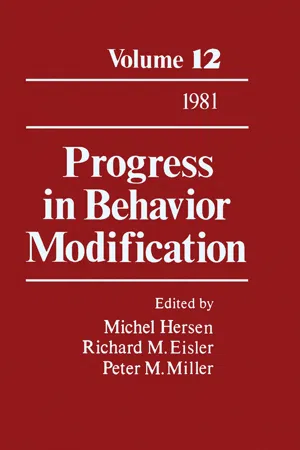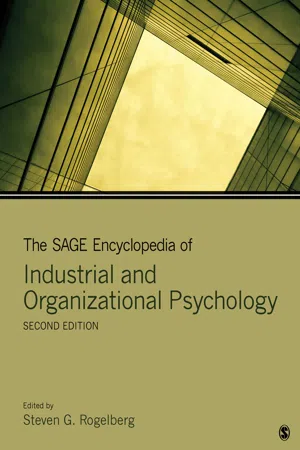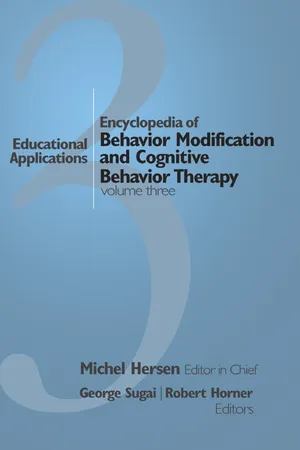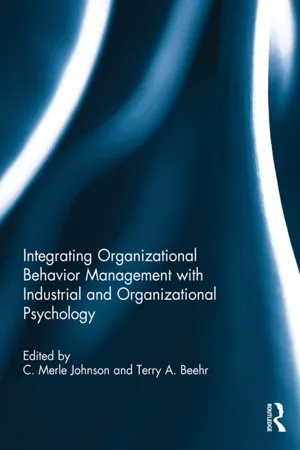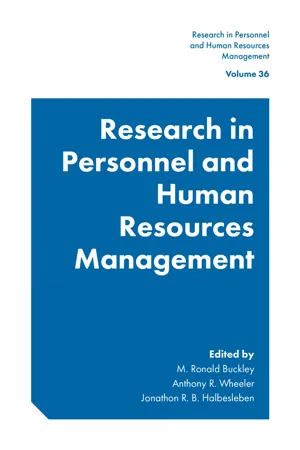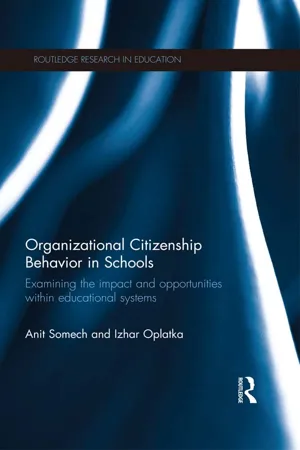Business
Organizational Behavior Management
Organizational Behavior Management (OBM) is the application of behavioral principles to improve workplace performance and enhance organizational effectiveness. It involves analyzing and modifying employee behavior through techniques such as goal-setting, feedback, and reinforcement. OBM aims to create a positive work environment, increase productivity, and foster a culture of continuous improvement within the organization.
Written by Perlego with AI-assistance
Related key terms
1 of 5
12 Key excerpts on "Organizational Behavior Management"
- Stephen F. Davis, William Buskist, Stephen F. Davis, William F. Buskist(Authors)
- 2007(Publication Date)
- SAGE Publications, Inc(Publisher)
Thus, if a manager can understand how to change behavior and maintain that change, she will have a significant advantage over her competitors. Organizational Behavior Management (OBM) is a “systematic, data-oriented approach to managing behavior in the workplace” (A. C. Daniels, 1989, p. 4) and can provide such an advantage. 1 Because of the competitive nature of business in today’s global and fast-paced economy, there is a great deal of pressure on organizations to (a) change rapidly in order to keep pace and (b) employ methods that their competitors are using. This pressure to change rapidly can result in organizations implementing popular interventions without empirical support for efficacy. Consequently, organizations may spend an inordinate amount of money on ineffective systems (e.g., management by wandering around). In a popular 1980s book, Peters and Waterman (1982) identi-fied 43 organizations they considered to be excellent for a number of reasons. Bailey and Austin (1996), however, subsequently reanalyzed these organizations and reported that only 14 of the original 43 organizations would have still been considered excellent just 2 years later. Why such attrition? Most likely, these organizations were imple-menting unsupported fads that did not sustain long-term, real performance change. OBM, in contrast, approaches workplace people problems by relying on science-based methods and behavior-analytic principles. 1 Organizational Behavior Management is also called perfor-mance management (A. C. Daniels, 1989). Organizational Behavior Management • 449 Behavior analysis is the scientific study of behavior, and applied behavior analysis (ABA) is the application of behavioral principles in an attempt to solve problems of social relevance (Baer, Wolf, & Risley, 1968). Although behavioral researchers have studied basic principles of learning for well over a century, they began applying these principles in the workplace only in the 1960s.- eBook - ePub
Applied Behavior Science in Organizations
Consilience of Historical and Emerging Trends in Organizational Behavior Management
- Ramona A. Houmanfar, Mitch Fryling, Mark P. Alavosius, Ramona A. Houmanfar, Mitch Fryling, Mark P. Alavosius(Authors)
- 2021(Publication Date)
- Routledge(Publisher)
12Interbehavioral Psychology and Organizational Behavior Management Mitch Fryling, Linda J. Hayes, and Will FlemingDOI: 10.4324/9781003198949-12Organizational Behavior Management (OBM) is a subfield of Applied Behavior Analysis (ABA) that focuses on the study of behavior within organizational settings (Wilder et al. in this text). As a distinct area of application within ABA, OBM has many unique features. For instance, while it may be argued that all settings are complex in the sense that they are multi-factored, behavior occurring in organizational settings may be especially prone to influence from contextual factors. Though the field of behavior analysis may be increasingly interested in studying contextual variables, the study of behavior in organizations requires us to think more contextually than many in behavior analysis are accustomed to doing. Moreover, this complexity is related to how we think about behavior more generally, including what we are studying and how we go about studying it. We draw attention to these conceptual hurdles not only because they are relevant to the development and refinement of the philosophical foundation of ABA and OBM specifically, but also because humans spend much of their lives behaving in organizational settings and organizations are involved in many of the most important issues in society today. As such, getting a better grasp on what we are studying in OBM has social implications, influencing the focus of research and the development of applied technology.The aim of the present chapter is to highlight some themes in the OBM literature, emphasizing the conceptual problems they raise, and to propose potential solutions and future directions. Our chapter is conceptual in nature, and is informed by interbehaviorism (Kantor, 1953) and Interbehavioral Psychology (Kantor, 1958). In particular, we address matters related to the complexity of the subject matter in OBM, the relationship of OBM to basic behavioral principles, and interdisciplinary science. - eBook - PDF
Progress in Behavior Modification
Volume 12
- Michel Hersen, Richard M. Eisler, Peter M. Miller, Michel Hersen, Richard M. Eisler, Peter M. Miller(Authors)
- 2013(Publication Date)
- Academic Press(Publisher)
First, OBM is clearly behavioral in its roots and methodological procedures. Second, it is broad in its areas of concern. It focuses on improving either individual or group performance in virtually any organizational context. Third, it is decidedly practical in its emphasis, with the ultimate goal being the establishment of a technology of behavioral management in organiza-tions. A similar definition emerged from a recent survey of OBM research-ers and practitioners (Frederiksen & Lovett, 1980). Based on a content analysis of responses, a consensual definition of the field was developed. This definition outlined the following four major characteristics of OBM: 1. Theoretical basis. OBM is primarily based in operant psychology. The work of B.F. Skinner and related theorists is widely accepted as the most common theoretical ground. While many practitioners are moving toward a more cognitively oriented social-learning approach, almost all accept the common theoretical label of behavioral. 2. Methodology. It utilizes the methodology of applied behavior analysis. Particularly salient features include the direct observation of behavior, the use of single subject methodology, the demonstration of experimental rather than statistical control, and the use of practical rather than statistical criteria for significance. Organizational Behavior Management 69 3. Subject matter. Organizational Behavior Management focuses on the analysis of behavior in organizational settings. Some of these organiza-tions include businesses and industries, human service settings, schools, governments, and community organizations. The unit of analysis is both the individual and the group. Likewise, the focus is on virtually any kind of behavior that has an impact on the effectiveness of the organization in achieving its goals (e.g., task completion, absenteeism, safety, customer service, delivery of clinical services, etc.). - Steven G. Rogelberg(Author)
- 2016(Publication Date)
- SAGE Publications, Inc(Publisher)
Organizational Behavior Management Organizational Behavior ManagementJudith L. Komaki Judith L. Komaki Komaki, Judith L.1065 1073Organizational Behavior Management
Judith L. KomakiOrganizational Behavior Management (OBM) takes the principles of B. F. Skinner’s reinforcement theory and applies them in organizations. Its guiding philosophy is that our behavior is shaped and maintained by the environment, especially its performance consequences. Rarely are efforts made to change workers’ attitudes or personalities. Instead most interventions or efforts to improve performance involve rearranging the situation so that favorable consequences—a thumbs-up, scores posted on a graph, the way paved to a coveted promotion—consistently occur when workers perform as desired. This intervention, referred to as positive reinforcement, is the most prevalent in OBM.Embodying the Scientist–Practitioner Model
Psychologists are encouraged to apply psychological principles, while at the same time checking to see if evidence supports their application. The same scientist–practitioner model is extolled in OBM. Behavior analysts typically evaluate treatment programs—whether they be strictly positive reinforcement or positive reinforcement coupled with directives—for their effectiveness. Testimonials or opinions, no matter how raving or expert, are no substitute for data. So strong is this belief in rigorous assessment that the primary journal in the field, the Journal of Organizational Behavior Management- eBook - PDF
Encyclopedia of Behavior Modification and Cognitive Behavior Therapy
Volume I: Adult Clinical Applications Volume II: Child Clinical Applications Volume III: Educational Applications
- Michel Hersen(Author)
- 2005(Publication Date)
- SAGE Publications, Inc(Publisher)
So, OBM interventions are devised to change behavior of a given workforce that has been determined to possess the aptitude for skills improvement and potential for behavioral shaping required to achieve results that support achievement of the organization’s mission, goals, and performance (e.g., goods production or service delivery). — John Austin and Thomas C. Mawhinney See also: Behavioral Consultation (Vol. I); Behavior Management (Vol. III); Behavior Management for Improving Academic and Classroom Behavior (Vol. II) Suggested Readings Abernathy, W. B. (2000). Managing without supervising: Creating an organization-wide performance system. Memphis, TN: PerfSys Press. Braksick, L. W. (2000). Unlock behavior, unleash profits. New York: McGraw-Hill. Daniels, A. C. (1989). Performance management: Improving quality productivity through positive reinforcement. Tucker, GA: Performance Management Publications. Daniels, A. C. (1994). Bringing out the best in people. New York: McGraw-Hill. Daniels, A. C. (2001). Other people’s habits. New York: McGraw-Hill. Frederiksen, L. W. (Ed.). (1982). Handbook of Organizational Behavior Management. New York: Wiley. Gilbert, T. F. (1978). Human competence: Engineering worthy performance. New York: McGraw-Hill. Hayes, L., Austin, J., Houmanfar, R., & Clayton, M. (Eds.). (2001). Organizational change. Reno, NV: Context Press. Johnson, C., Mawhinney, T. C., & Redmon, W. (Eds.). (2001). Handbook of organizational performance: Behavior analy- sis and management. Binghamton, NY: Haworth Press. Luthans, F., & Kreitner, R. (1985). Organizational behavior modification and beyond. Glenview, IL: Scott, Foresman. O’Brien, R. M., Dickinson, A. M., & Rosow, M. P. (Eds.). (1982). Industrial behavior modification. New York: Pergamon Press. Rummler, G. A., & Brache, A. P. (1995). Improving perfor- mance: How to manage the white space on the organiza- tion chart (Rev. ed.). - eBook - ePub
Interdisciplinary Research in Technology and Management
Proceedings of the International Conference on Interdisciplinary Research in Technology and Management (IRTM, 2022), 24-26th February 2022, Kolkata, India
- Satyajit Chakrabarti, Ashiq A. Sakib, Rohit Singh, Pradipta Kumar Banerji, Sanghamitra Poddar, Anupam Bhattacharya, Malay Gangopadhyaya, Srijita Chakraborty, Satyajit Chakrabarti, Ashiq A. Sakib, Rohit Singh, Pradipta Kumar Banerji, Sanghamitra Poddar, Anupam Bhattacharya, Malay Gangopadhyaya, Srijita Chakraborty(Authors)
- 2023(Publication Date)
- CRC Press(Publisher)
Behavioural operations management is the study of how organizational behaviour, interacts with operations management, systems and processes. The field of operations management known as behavioural operations m anagement (BOM) focuses on the role of humans in operational settings [ 2 ]. The OM field provides rich situations that aid in the study of crucial and relevant micro-level people issues and the promotion of core behavioural ideas [ 3 ]. Inventory decisions, particularly those inside the news vendor framework, were the subject of the first incursion in behavioural operations studies as one of the building blocks in OM research [ 4 ]. Engineering and designing corporate processes that foster the desired behaviour (for example, increasing trust and trustworthiness), leading to cooperation, is one of the method for changing behaviour [ 5 ]. Based on the tools and techniques of mathematical modelling, human behaviour plays a vital role in Operations Management. The field of operations dates back to Frederick Taylor’s early twentieth-century time-motion investigations. Much has changed since then, both in terms of the environment (technology, globalization, etc.), the nature of operations and the process of operations (network architecture, information systems, lean manufacturing, capacity planning, inventory models, forecasting methodologies, project management methods, then on). People are a vital component of the system in the vast majority of operations, from manufacturing and services to supply chains and R&D. People may have a considerable impact on how operating systems run, perform, and respond to management interventions, given the importance of human behaviour in operations - eBook - PDF
- James L. Bowditch, Anthony F. Buono, Marcus M. Stewart(Authors)
- 2015(Publication Date)
- Wiley(Publisher)
C H A P T E R O N E Management and Organizational Behavior M anagement education and development have traditionally emphasized what might be termed the content of managerial work. Indeed, much of management edu- cation today continues to focus on upgrading the technical competence of managers and managers-to-be in such areas as accounting, finance, marketing, operations, and information technology–related services. This focus on content has been referred to as the what of a manager’s job, encompassing such concerns as: developing appropri- ate procedures for auditing and inventory control; creating new marketing programs; establishing management information systems, just-in-time inventory, and produc- tion systems; enhancing global supply chain efficiencies; and other specific aspects of managerial work. 1 While the technical aspects of management are, of course, quite important for the successful functioning of an organization, understanding the process of management or the how of a manager’s job is also a critical component of management educa- tion. Within this process view of management, attention is often given to the roles, behaviors, and skills that are necessary for effective managerial performance. Some of these behavioral skills are communicating with peers, subordinates, and bosses; obtaining and sharing information; running meetings; allocating resources to differ- ent groups; and handling conflict within or between teams. 2 This understanding of management processes, often referred to as organizational behavior (OB), thus ex- tends managerial education to the study of people, groups, and their interactions in organizations. Recent analyses of our changing business environment reflect the importance of this dimension of management, and corporations are demanding a much broader range of skills and competencies from their business professionals. - eBook - ePub
Misbehavior in Organizations
A Dynamic Approach
- Yoav Vardi, Ely Weitz(Authors)
- 2016(Publication Date)
- Routledge(Publisher)
I Organizational Misbehavior (OMB)Passage contains an image
1 Organizational Behavior and Misbehavior
DOI: 10.4324/9781315732565-1Problematic behavioral manifestations in the organized workplace are not new. F. W. Taylor (1895 , 1903 ) brought the practice of soldiering or goldbricking—deliberately slowing down production—to light. The early proponents of the Human Relations School reported extensively on production restriction and rate-busting (and their consequences) as early as the 1920s (Roethlisberger & Dickson, 1964 ). Greenberg and Scott (1996 ) dated employee theft (a major form of organizational misbehavior) to ancient times. These phenomena are unquestionably universal. Therefore, it is safe to assume that most, if not all, members of work organizations, throughout their employment, engage in some form of misbehavior related to their jobs, albeit in varying degrees of frequency and intensity. Hence, to achieve a better understanding of organizational behavior (OB), we must study organizational misbehavior as well. Organizational misbehavior (OMB) is defined as acts in the workplace that are committed intentionally and constitute a violation of rules pertaining to such behaviors. We strongly believe that, to truly comprehend the behavior of people at work and the functioning of organizations, social scientists need to explore and research both the positive and negative aspects of work-life. After all, how can we understand the functional if we fail to recognize the dysfunctional and unconventional?During the past three decades, organization scholars have become more willing to acknowledge that various forms of work-related misbehavior by employees and managers are prevalent, and that their consequences for employers are indeed quite significant and costly (e.g., Neuman & Baron, 2005 ; Griffin & Lopez, 2005 ; Berry et al., 2007 ; Greenberg, 2010 ; Hershcovis & Barling, 2010 ; Tepper & Henle, 2011 ). Such behaviors range a full spectrum from minor to serious—a mere perception of violation of the psychological contract (e.g., Bordia et al., 2008 ); minor workplace incivility (e.g., Lim et al., 2008 ; Reich & Hershcovis, 2015 ); insulting behaviors (e.g., Francis et al., 2015 ); workplace social undermining (e.g., Duffy et al., 2006 ); knowledge-hiding (e.g., Connelly et al., 2012 ); theft of company assets (e.g., Tomlinson & Greenberg, 2007 ); cyberloafing (e.g., Weatherbee, 2010 ; Kidwell, 2010 ); acts of destructiveness, vandalism, and sabotage (e.g., Skarlicki et al., 2008 ); substance abuse while at work (Frone, 2008 , 2013 ); aggression perpetrated against fellow employees or toward the organization (e.g., Neuman & Baron, 2005 ; Barling et al., 2009 ; Hershcovis & Barling, 2010 ; Hershcovis & Reich, 2013 ); bullying (e.g., Einarsen et al., 2011 ); and abusive supervision (Tepper, 2007 ; Mackey et al., 2015 - eBook - ePub
- C. Merle Johnson, Terry Beehr, C. Merle Johnson, Terry Beehr, Terry A. Beehr, C. Merle Johnson, Terry A. Beehr(Authors)
- 2013(Publication Date)
- Routledge(Publisher)
sensitivity to the role of JS in JP. While it is tempting to assume OBM interventions improve or maintain participants’ JS, I have indicated why this could be an unfounded assumption (Mawhinney, 1984, 1989). Suffice it to say, some members of the OBM culture share the IOP culture’s concern for developing organizational practices that facilitate employee JS and effective and efficient JP.The OR construct(s) in the IOP culture “does not seem to be a topic that receives much attention in the literature of mainstream I/O psychology, or even psychology in general” (Aguinis, 2010, p. 855). The reason may appear in Aguinis’ (2010) definition of OR “as context-specific organizational actions and policies that take into account stakeholders’ expectations and the triple bottom line of economic, social, and environmental performance [emphasis added].” (p. 858). Assessing an organization’s performance on any one of these dimensions is no small task, let alone assessing performance on all of them. On the other hand, Wolf (1978) pinpointed , if a bit broadly, the behavior among members of ABA and, de facto today, the OBM culture as well, what would be classified as contributing to social validity of members’ behavior and accomplishments :1. The social significance of the goals . Are the specific behavioral goals really what society wants? 2. The social appropriateness of the procedures . Do the ends justify the means? That is, do the participants, caregivers and other consumers consider the treatment procedures acceptable ? [emphasis added] 3.The social importance of the effects . Are consumers satisfied [emphasis added] with the results? All the results, including any unpredicted ones?(p. 207)Given the diversity among our customers, it is reasonable to conclude that we should use a contingency approach to assessing SV of our interventions and design client-specific or standardized practices or systems depending on client or customer needs. For models in our literature see the following: Ludwig and Geller (2000), McSween (2003), Wolf, Kirigin, Fixsen, Blase, and Braukmann, (1995). This, of course, begs the question, “Who are our customers?” (Schwartz & Baer, 1991). Within organizations, who we and our customers are depends upon whom and where individuals are situated in the FO system. - M. Ronald Buckley, Anthony R. Wheeler, Jonathon R. B. Halbesleben, M. Ronald Buckley, Anthony R. Wheeler, Jonathon R. B. Halbesleben(Authors)
- 2018(Publication Date)
- Emerald Publishing Limited(Publisher)
Bateman and Organ (1983) published the first empirical examination of organizational citizenship behavior (OCB) and demonstrated that employees who were satisfied with their jobs engaged in higher levels of OCB, including behaviors like protecting organizational property, training and helping others to perform their jobs better, taking a personal interest in other employees, coming up with new ideas for handling work, cooperating well with those around them, refraining from complaining and finding fault with other employees, and so forth.Since this initial study, research on OCB has increased exponentially. Indeed, by 2014, over 2,100 articles on OCB had been published, according to Podsakoff, Podsakoff, MacKenzie, Maynes, and Spoelma (2014) . Generally speaking, researchers in organizational behavior tend to favor the OCB label, and they make a distinction between in-role (i.e., formally prescribed) job performance and OCB; somewhat differently, human resource management (HRM) scholars often use the contextual performance label and make a distinction between contextual behavior, which supports the broader organizational social and psychological environment within which task performance occurs, and task performance, which is the performance of formally assigned tasks that contribute to the organization’s technical core. Organ (1997) even argued that it might be better to redefine OCB as synonymous with contextual performance or “contributions to the maintenance and enhancement of the social and psychological context that supports task performance” (p. 91) in order to address critiques regarding the definition of OCB (e.g., Morrison, 1994 , Van Dyne, Cummings, & McLean Parks, 1995 ) with regard to it being beyond role requirements (i.e., extra-role) and unrewarded. More recently, though, Organ et al. (2006) returned to a definition closer to the original conceptualization; specifically, they define OCB as: “Individual behavior that is discretionary, not directly or explicitly recognized by the formal reward system, and in the aggregate promotes the efficient and effective functioning of the organization” (p. 3). Often researchers contrast OCB with task performance when defining it. For instance, Bolino, Hsiung, Harvey, and LePine (2015)- eBook - ePub
Organizational Citizenship Behavior in Schools
Examining the impact and opportunities within educational systems
- Anit Somech, Izhar Oplatka(Authors)
- 2014(Publication Date)
- Taylor & Francis(Publisher)
In part because of its contribution to organizational outcomes, such as productivity and profit (Kizilos, Cummings, & Cummings, 2013; Poropat & Jones, 2009), a significant research effort has been made to understand the OCB phenomenon and its antecedents and consequences. These “extra” or “voluntary” behaviors, when aggregated over a number of individuals and some period of time, are expected to improve organizational functioning and, in turn, organizational effectiveness (N. P. Podsakoff, Whiting, P. M. Podsakoff, & Blume, 2009; Turnipseed, 2005).This chapter begins by reviewing the development, nature, and construct of the concept in organizations outside the educational context, and reveals that OCB conceptualization is still fraught with incompleteness and inconsistencies. Following this, we summarize the empirical evidence regarding the impact of OCB on the employee and on the organization as a whole. This chapter sets the stage for the in-depth discussion of teacher OCB in the book.Definition of OCB
Scholars have offered various definitions and constructs to characterize the concept of employee OCB, which was coined by Organ and his colleagues (Bateman & Organ, 1983; Smith et al., 1983). At first, the emphasis was on discretionary, unrewarded behavior that employees do not receive training to perform. OCB was considered to be an extra-role behavior that falls outside the rubric of task performance (Borman & Motowidlo, 1997; Organ & Ryan, 1995)—a behavior engaged in with no expectation for recognition or compensation (Lev & Koslowsky, 2012). In this sense, Bateman and Organ (1983) proposed the term OCB to designate behaviors which “include any of those gestures (often taken for granted) that lubricate the social machinery of the organization but that do not directly inhere in the usual notion of task performance” (p. 588).Later, in his classic book Organizational Citizenship Behavior: The Good Soldier Syndrome - eBook - ePub
Organizational Behavior Management and Developmental Disabilities Services
Accomplishments and Future Directions
- Dennis H Reid(Author)
- 1998(Publication Date)
- Routledge(Publisher)
Finally, we believe that a much more basic point should be asked about the potential meaning of statistical control in data measuring performance within human service environments. Do we wish to assume, and teach managers and key executives, that statistical control in repeated measures means that random variability is inherent in the current design of the process? That might be helpful in person-machine interactions where non-systematic variations in the materials, the machine performance, and operator behavior interact to produce variation that is difficult to eliminate without systems-level changes (e.g., working with the supplier on increasing the consistency of materials purchased). Or, is most of the variability in performance within human service settings controlled by weak social variables operating in the environment? In the case of the person-machine-material interface, OBM interventions using social contingencies might (or might not) be appropriate if the process is within statistical control. However, in the case of human interactions controlled by weak social contingencies operating in complex and apparently non-systematic ways, one of the first things to do is probably to consider whether, and how, it would be helpful to the consumer to intervene to create better staff interaction patterns. If it would, and we can, then an intervention to prompt and shape staff behavior using supervisory contingencies might be an appropriate place to start almost regardless of the momentary level of variability in the data.Concluding Comments
A growing yet relatively small number of large-scale OBM studies have improved quality in DD organizations over extended periods of time. These incremental efforts and a complete organizational transformation of at least one human service agency demonstrate that behavioral supervision of important performances can be highly effective in DD organizations. Indeed, the literature includes a number of systematic replications of effective interventions in these settings. However, both the small number of large-scale, long term studies and the relatively limited number of performances targeted by these studies, suggest that expanded use of OBM as a pervasive technology for improving quality in DD organizations has yet to occur.TQM efforts provide an approach to organizational change at a systemic level using cross-functional teams to identify and solve important problems related to quality defined as the satisfaction of consumers on all of the relevant dimensions. In considering the OBM literature in DD organizations on four components of TQM approaches, this paper concludes that in most areas, integrating OBM and TQM in DD organizations may expand the scope and effectiveness of both approaches. In some areas (organizational systems analysis) OBM may gain from TQM’s practical emphasis
Index pages curate the most relevant extracts from our library of academic textbooks. They’ve been created using an in-house natural language model (NLM), each adding context and meaning to key research topics.


